A factory
Our brain is a factory of emotions. An emotion is important information. Emotions heal when they are heard and validated. The brain, emotions and hormones are deeply interconnected, together they form a network. It takes an entire human body system to process information. Emotions such as fear, love, sadness, surprise don't just pop up. They are a result of a massive teamwork which leads to a synchronized emotional processing. Hence, it is necessary to develop insight about the role, functions and mechanism of what happens inside the brain. Developing awareness is a basic step towards self-care, to improve one's mental health. Let us dive inside the brain to know thyself.
Ever since brain studies have evolved and progressed step by step, the importance of educating and using the brain effectively has increased. Neurological studies mention the concept of “neuroplasticity “in the human brain. It explains the classic ability of the brain to mold, respond, reset, grasp and also delete the unwanted information as individuals grow. Hence, considering this ability, varied theorists suggest strategies to ‘train the brain’, ‘to develop the brain’, ‘to control the brain’ and ‘to use it effectively’. For example, theories of Emotional Intelligence and Mindfulness focuses on the possibility to develop awareness about the innumerable simultaneous activities happening within. It is a way of paying attention moment to moment to what is happening within and around us without judgment. Over the years, the role of the brain, emotions, and its impact on behavior has become the basis for numerous therapeutic interventions. As the interest in these areas has grown exponentially, in order to develop mindfulness, it is necessary to closely understand the human brain and its role towards our mental well-being.
“Our minds influence the key activity of the brain, which then influences everything; perception, cognition, thoughts and feelings, personal relationships; they're all a projection of you.” - Deepak Chopra
The two minds
…she recently shifted to a new city, weaving new dreams and spreading her wings, aiming for freedom. She felt happy, strong, brave and powerful. By dawn, she felt lonely, a bit saddened. She kept telling her parents on call she is doing great and was teary eyed at the same time. She wept, but she said “I am okay.”
An example like this is a classic reflection of our brain functions. There is an unusual mixture of emotions and actions. A magical contradiction where words were contrary to her feelings, clearly. One was an act of an emotional mind and the other was one of a rational mind. We have two minds, the one that feels and the one that thinks. Fundamentally, we have two different ways of structuring our mental life. Let us understand both.
The emotional mind is the job done by heart. It is powerful, intense, impulsive and sometimes illogical. These are the situations when one feels or “knowing something is right, in my heart” a strong conviction, having a deeper kind of order.
The rational mind is more aware, thoughtful, and is able to ponder, examine, analyze and reflect. The work is of the head here. The more intense the feeling, the more dominant is the emotional brain and the more ineffectual is the rational brain. But, both of these minds function together in harmony to draw conclusions from our everyday life situations. They are interconnected, intertwined and guide us through the world. Mostly, these minds are systematically coordinated, but when passion surges, the emotional brain comes into power. In simple words, there is a constant war between the feeling (emotional mind) and the reason (rational mind). The key is to coordinate them well. Fields like astrology, psychology, physiology, spirituality etc. define “the mind” differently. These theories provide suggestions toward living a fulfilling life. There are varied interpretations shared by great researchers and scholars. Buddha and the concept of mind, focuses on mind as a process and not a substance and believes nothing is permanent. The physiological basis also explains that emotions keep changing.
This is exactly what mindfulness is about. It is the understanding and practicing awareness of each possible moment. It involves monitoring our feelings and our actions thereby building skills to maintain harmony in our lives. As we understand the two minds, there is a huge army behind these processes. Each brain part has a specific function, and all the parts reciprocate with each other. Let us dive in to know more.
The team players!
The human brain is a complex system to decode. When it comes to understanding behavior and emotions, it is necessary to understand the function of each team player.
The Limbic System has two powerful tools- learning and memory. It is a seat of all passion. A powerhouse of emotions.
The Limbic System comprises - The Amygdala, The Hippocampus, The Hypothalamus, The Thalamus and The Pituitary glands.
If one has suffered a dog bite, then the amygdala may help in processing that event and, therefore, increase your fear or alertness around the dogs. It is best known as the part of the brain that drives the “fight or flight” response. It plays an important role in helping store memories of events and emotions so that an individual may recognize similar events in future. The amygdala is the storehouse of the emotional memory. Life without an amygdala is life without meaning. It is an almond shaped cluster above the brainstem, near the bottom of the limbic ring. There are two amygdalae in the human brain, one on each side of the brain. It is best known for its role in fear processing. For example, when we are exposed to a fearful stimulus in a situation, information regarding that stimulus is immediately sent to the amygdala, which then sends signals to areas of the brain which prepares the person for action, to either fight with the situation or take a flight and leave.
The Hippocampus is a complex brain structure embedded deep into the temporal lobe. It is more involved in registering and making the sense of the perceptual patterns than the emotional reactions. The reaction part is taken care of by the amygdala. For example, if one meets with a sudden accident on a highway, due to a heavy loaded truck full of car parts. Post-accident, the hippocampus will help the individual retrieve the accident facts such as the type of the truck, the type of the load, the name of the highway, the place of the accident from its memory. While the amygdala, will send a surge of anxiety or fear or may create alertness in that same person when he tries to drive a car in a similar situation again. LeDoux, an American neuroscientist explains the two in the best possible ways, “The Hippocampus is crucial in recognizing a face as that of your cousin. But it is the amygdala that adds that you don’t really like him!”
The Hypothalamus mainly maintains your body’s internal balance. It is an integral part of the brain. It plays an important role in hormone production and helps to stimulate many important processes in the body such as maintaining body temperature, thirst, appetite and weight control, emotions, sleep cycles, sex drive, childbirth, blood pressure and heart rate and balancing body fluids.
Different systems and parts of the body send signals to the brain. They alert the hypothalamus to any unbalanced factors that need attention, the hypothalamus then responds by releasing the right hormones into the bloodstream to balance the body! How interesting this can be!
The Sensory Cortex, in simple terms, is responsible to process and make sense out of the information gathered by our five senses: vision, auditory (sound), olfaction (smell), gustation (taste) and somatosensorial (touch). It receives and processes bodily sensations. Body parts that are the most sensitive occupy the greatest amount of space in the sensory cortex.
The Prefrontal Cortex is the front part. It is implicated in planning complex cognitive behavior, personality expression, creativity, innovation, decision making and moderating social behavior. It is mostly addressed as the control center. For example, while planning a holiday, or planning for the future, the prefrontal cortex is at work. It also plays a crucial role in predicting the consequences of one's actions.
The Brainstem is the bottom part of your brain. It sends signals from your brain to the rest of your body. It controls many subconscious body functions such as breathing and maintaining the heart rate. The primary function is to maintain the basic survival processes. Sudden injuries, and the brain and heart conditions may affect how your brain stem works.
The Neocortex makes up approximately half the volume of the human brain. Its job is deep, complicated, and vital. It is responsible for the higher brain functions such as perception- an ability to understand things, making sense of something, situations etc.
It is responsible for decision making, language, understanding of space, patterns etc. When you are solving puzzles or a maze, you use your neo cortex! Interestingly, the species that have no neocortex, such as reptiles, lack maternal affection, when their young hatch, the newborns must hide to avoid being cannibalized.
Now that we get a hang of the mighty magical brain, read this example which might explain its connectedness. Love- The limbic structures generate feelings of pleasure and sexual desire. But the addition of the neocortex and its connections with the limbic system allowed mother-child bond that forms a basis of the child rearing process and makes human development possible.
Overall, the human brain is a complex organ to understand. Few parts take care of our physiological being and some function for our emotional being.
The basic emotional skills
“Life is a comedy for those who think and a tragedy for those who feel”- Horace Walpole
The boss was known to be the best one around. He was known to be a fantastic leader. He and his team were expected to reach a major year-end target. The company had also launched interesting incentives for the employees to reach the targets. At first, the boss encouraged everyone and tried to build a comfortable environment. The employees became competitive, the issues started scaffolding. The boss received daily emails which were viewed as pressure. In turn the pressure was passed to the employees, turning into a vicious cycle. The boss started having anger outbursts, like never before. Anger. In anger, a rush of hormones such as adrenaline generates a pulse of energy strong enough for a vigorous action.
All emotions are, in essence, impulses to act, the instant plans for handling life. Emotions lead to actions, and it is the most natural and an obvious process.
In order to understand life, it is important to become cognitively aware, and one of the right ways to improve behavior, control impulsive reactions, to avoid judgments, and improve perceptions is to practice mindfulness. An initial step of building awareness is to understand one’s own emotional makeup. An individual shapes his/ her life based on the environments they have belonged to, their experiences with people and places.
As we begin to understand our brain parts here, let us explore “what exactly happens when we have sudden emotional explosions or outbursts” as explained in the scenario above. The moments where all these parts work in rhythm to maintain our mental balance. One may not be well versed with the technical content or understand the brain anatomy fully, but one can surely explore the world of emotions.
* Why do things happen the way they happen?
* What can trigger us?
* What makes us upset?
* What are the ways to cheer oneself?
Everyday stressors are like the uninvited guests, they come with baggage which you are unaware of. Hence, interesting theories were researched. The results of the studies in emotional intelligence are remarkable.A Yale psychologist, Peter Salovey expands his theories into an Emotional Intelligence Model consisting of five main domains.
Knowing one emotion- as they happen. To notice “what is happening with me”.
Managing emotions- Building a capacity to soothe oneself, managing irritability, anxiety and ability to bounce back after a setback.
Motivating oneself- to be able to manage self during delays in life goals, ability to wait patiently and motivate oneself during delays.
Recognizing emotions in others- Empathy, is a fundamental people skill. Extremely important skill to understand the world.
Handling relationships- This basically involves managing emotions in others. These are important skills in order to communicate smoothly, building strong relationships. The purpose of being aware of these domains is the easiest way to understand our brain, the way our emotions affect our day-to-day life.
The Emotional Hijack!
It was the couple's first anniversary. It was a mutually well-planned celebration. The guy had bought a one-of-a-kind gift which his partner had always wanted. She loved painting. He had bought her an original painting of her favorite artist. It meant more than a diamond or gold. The guy being an explorer, the girl had booked a fancy dinner followed by a camping activity over the weekend. Everything seemed perfect. The guy had a tough day at work with a series of arguments with colleagues and bosses, reached home and the couple celebrated, the wife was shocked by the surprise and was overwhelmed. She felt the luckiest before the girl could share her surprise, the guy shared that he must report to the office early the next day.
Her delight dissolved. She was hurt and incredulous. She got up in tears, left the room and on impulse threw her painting and everything around!
Such emotional explosions are neural hijackings. The hijacking happens instantly. The hallmark of such hijacks is that once the moment passes, those who possess it have the sense of not knowing what came over them. But there are a few seconds of awareness before the outburst takes place and that is the time to self-control. It is in moments like these, the impulsive feelings override the rational. The amygdala here starts scanning all the experiences which might cause trouble. The individual starts questioning the life situations and magnifies the negative thoughts. The mental state challenges every situation. When the last time you have had angry outbursts on someone, when you had ‘lost it’ remember that the amygdala does the working. Evidence suggests that a center in the limbic brain proclaims an emergency and puts all other systems on an urgent agenda to protect oneself. These hijackings are sometimes fatal, horrific incidents and sometimes they can be filled with intense joy too. For example, when a joke strikes someone and leads to an uproarious laughter is an example of a limbic response. If one builds an awareness of such situations, one becomes mindful of their actions, or least can make attempts and build consciousness.
The grand finale- Creating harmony with emotions, thoughts, and life
Some people, despite intact intelligence, or with superior Intelligence Quotient (IQ), make disastrous choices in business and in their personal lives, can obsess or overthink endlessly over a simplest decision such as when to visit a friend or choose a shirt. Such people may have less access to emotional learning. The five domains of the EI model are important for survival which we unknowingly follow in our daily functioning. Emotional mindfulness is the key.
By this, we become aware of our emotions, they guide our moment-to-moment decisions, working hand in hand with the rational mind.
Finally, we have two minds, two kinds of brain and two different kinds of intelligence- rational and emotional. How we lead a life is not only based on our IQ but emotional intelligence too. Indeed, both cannot function without each other. There is no reason for a debate.
Ordinarily, when the prefrontal cortex, the sensory cortex, the thalamus, and the amygdala interact well, emotional intelligence rises along with intellect.
For example, taking a break during a stressful conversation, conveying the exact reason of what is upsetting you during a family discussion, knowing what might hurt a friend and finding ways to communicate well. Sometimes, reaching out to people in order to avoid assumptions, asking questions and trying to understand the situation better. One can share anger and frustrations in better ways such as sharing and avoiding direct burst outs. One can improve on taking ownership of their own behaviors and actions.
In order to live a better life, in order to lead a worthy life, the new paradigm doesn’t argue whether life is about the ‘heart or the head’, it urges each to find a balance between both. To reach that balance, one must understand the brain, be alert, talk about emotions and be mindful of one’s own mental wellbeing. Finally, one has to understand that although feelings are temporary, they might not always be facts one has to understand them better in order to protect their mental health.
“Show some emotions, as emotions can be intelligent!”






Comments